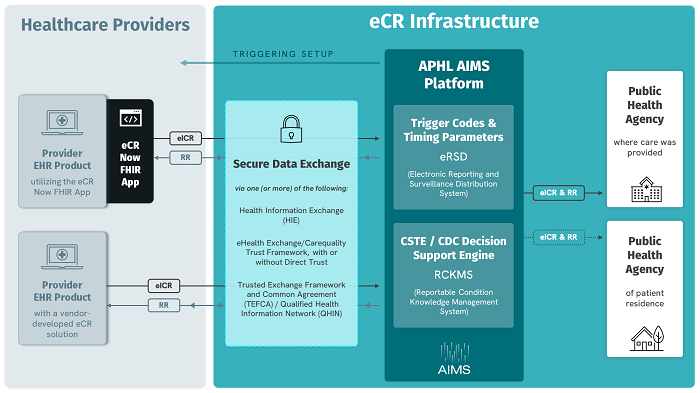eCR Now FHIR App
Since May 2020, the eCR Now FHIR App has provided electronic case reporting (eCR) capabilities for electronic health record (EHR) products that don’t have the ability to meet eCR requirements otherwise. It can simplify the EHR product preparation process and more rapidly enable eCR rollout to healthcare providers.
Rather than waiting for custom development cycles to build eCR functionality into their software, an EHR company that supports the Fast Health Interoperability Resources (FHIR) R4 API (required as part of the 21st Century Cures Act and the Office of the National Coordinator for Health Information Technology (ONC) Health IT Certification Program) can integrate the eCR Now FHIR App in their product(s) and more rapidly enable their customers to implement eCR.
The eCR Now FHIR App is open source and freely available for EHR industry partners to integrate with their products. While the use of the eCR Now FHIR App is not required, it does provide eCR capabilities for any EHR product and will help EHRs meet the ONC Health IT Certification Program criteria.
The eCR Now FHIR App manages:
- Triggering the creation of electronic initial case reports (eICRs) and the transmission of eICRs to the Association of Public Health Laboratories (APHL) Informatics Messaging Service (AIMS) Platform.
- The maintenance of trigger codes and timing within EHRs using the electronic reporting and surveillance distribution (eRSD) specifications.
- The receipt and filtering of Reportability Responses (RRs).

Benefits of the eCR Now FHIR App for EHRs
- It can be implemented quickly into EHR products, allowing customers to avoid service disruptions from migrations and upgrades that are often required by custom-developed eCR solutions.
- It can automate eCR reporting without disruption to provider or staff workflows.
- It is available at no cost.
- It enables the transmission of eICRs to PHAs.
- It allows HCOs to begin participating in eCR quickly to comply with the Centers for Medicare & Medicaid Services (CMS) rules for the Medicare Promoting Interoperability Program (PI) and Merit-based Incentive Payment System (MIPS).
- It decreases maintenance tasks for EHRs and HCOs by allowing more automated updates to triggers through the eRSD.
- It is a way for EHRs to achieve compliance and certification, as identified in ONC Health IT Certification criteria.
Attributes of the eCR Now FHIR App
- It produces fully validated, outgoing CDA eICR R3.1.1 (HL7 CDA® R2 Implementation Guide: Public Health Case Report, Release 2: the Electronic Initial Case Report (eICR), Release 2, STU Release 3.1.1 - US Realm) documents and CDA eICR R1.1 (HL7 CDA® R2 Implementation Guide: Public Health Case Report Release 2: the Electronic Initial Case Report (eICR) Release 1, STU Release 1.1 - US Realm).
- Supports the testing of the FHIR eCR 2.1.2 (HL7 FHIR® Implementation Guide: Electronic Case Reporting (eCR) - US Realm 2.1.2 - STU 2 US) and will support production FHIR use soon.
- It supports transport to the AIMS Platform, including support for Direct Secure Messaging and an interface for XDR and other secure transport options.
- It receives and sorts the returned Reportability Responses, identifying those that should be notified to the provider of record and attached to the patient’s chart from those that just support EHR system administration needs.
- It processes up-to-date trigger codes and reporting parameters from the eRSD system, minimizing health system and EHR trigger code management.
- It provides local storage of eICRs that have been sent.
- It supports automated launch capabilities for complete background operation, including:
- SMART on FHIR Backend Services-based launch, authentication, and authorization.
- Simple REST API to launch the processing of a patient when provided with patient ID, encounter ID, and a FHIR Server URL.
- The App can trigger an eICR on all of the following:
- Lab Orders
- Diagnoses and suspected diagnoses
- Lab Results
- Lab Result Test Names
- Medications
See the EHR Triggering page for more information.
Implementation
The eCR Now FHIR App is intended to run as a background process during patient encounters and report automatically to appropriate public health jurisdictions and their surveillance systems through the AIMS Platform. In this way, it should not burden or disrupt healthcare provider workflows.
Healthcare organizations, providers, and public health can request EHR companies to adopt the eCR Now FHIR App by submitting a ticket or through their usual procedures.
Next Steps
- Access the current version of the eCR Now FHIR App and its source code from the GitHub site.
- Submit any issues or questions by creating a ticket through our eCR service desk.
- Connect with the eCR Team via the eCR service desk early to plan an onboarding and coordination process.
- View more technical information on our EHR Implementers (aimsplatform.org) pages.
